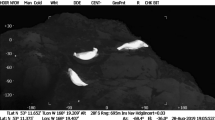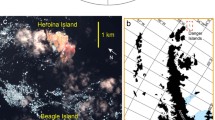Abstract
Detecting dolphins, accurately identifying species, and estimating group size during manned aerial surveys can be challenging. We used images obtained during a manned aerial survey over 13 non-consecutive days and covering a total of 3732 km of transects, in a high-wing aircraft flown at 185 km/h and an altitude of 152 m, equipped with three Single Lens Reflex cameras, to supplement estimates of dolphins recorded by observers. We used this opportunity to assess the adequacy of the resulting images for species identification of two morphologically similar dolphin species (i.e., with similar coloration and body size): the Indo-Pacific bottlenose dolphin (Tursiops aduncus) and the Australian humpback dolphin (Sousa sahulensis) and to accurately estimate dolphin group size. We also compared dolphin group estimates and species identification made by observers during the aerial survey, with manual review of the aerial images, where images overlapped with the observers’ field of view from the aircraft. We collected and reviewed 413000 images and found that an image resolution of 1.25 cm per pixel was adequate to distinguish between the two targeted dolphin species. Our findings suggest that aerial images can improve species identification and estimates of group size > 5. The camera setup and photography parameters that we describe here, with the survey altitude and speed that were used, has the potential to be used to identify, and accurately estimate other morphologically similar small-bodied (< 3 m) species in the marine environment. This will be an important consideration for future aerial surveys of low density, threatened species, that form small and sometimes mixed species groups, including humpback and bottlenose dolphins where their distribution overlaps.


Similar content being viewed by others
Change history
30 September 2022
Supplementary Information was updated
References
Angliss RP, Ferguson MC, Hall P, Helker V, Kennedy A, Sformo T (2018) Comparing manned to unmanned aerial surveys for cetacean monitoring in the Arctic: methods and operational results. J Unmanned Veh Syst 6:109–127. https://doi.org/10.1139/juvs-2018-0001
Bayliss P (1986) Factors affecting aerial surveys of marine fauna, and their relationship to a census of dugongs in the coastal waters of the northern-territory. Wildl Res 13:27–37. https://doi.org/10.1071/WR9860027
Braulik G, Natoli A, Kiszka J, Parra G, Plön S, Smith BD (2019) Tursiops aduncus. e.T41714A50381127. https://doi.org/10.2305/IUCN.UK.2019-3.RLTS.T41714A50381127.en
Bröker KCA, Hansen RG, Leonard KE, Koski WR, Heide-Jørgensen MP (2019) A comparison of image and observer based aerial surveys of narwhal. Mar Mamm Sci 35:1253–1279. https://doi.org/10.1111/mms.12586
Brown AM, Bejder L, Parra GJ, Cagnazzi D, Hunt T, Smith JL, Allen SJ (2016a) Sexual dimorphism and geographic variation in dorsal fin features of Australian humpback dolphins, Sousa sahulensis. Adv Mar Biol 73:273–314. https://doi.org/10.1016/bs.amb.2015.08.002
Brown AM, Bejder L, Pollock KH, Allen SJ (2016b) Site-specific assessments of the abundance of three inshore dolphin species to inform conservation and management. Front Mar Sci. https://doi.org/10.3389/fmars.2016.00004
Buckland ST, Anderson DR, Burnham KP, Laake JL, Borchers DL, Thomas L (2001) Introduction to distance sampling. Oxford University, Oxford, pp 280–287
Carretta JV, Forney KA, Laake JL (1998) Abundance of the Southern California coastal bottlenose dolphins estimated from tandem aerial surveys. Mar Mamm Sci 14:655–675. https://doi.org/10.1111/j.1748-7692.1998.tb00755.x
Caughley G (1974) Bias in aerial survey. J Wildl Manag 38:921–933. https://doi.org/10.2307/3800067
Chivers SJ, Perryman WL, Lynn MS, Gerrodette T, Archer FI, Danil K, Berman-Kowalewski M, Dines JP (2016) Comparison of reproductive parameters for populations of eastern North Pacific common dolphins: Delphinus capensis and D. delphis. Mar Mamm Sci 32:57–85. https://doi.org/10.1111/mms.12244
Cleguer C, Kelly N, Tyne J, Wieser M, Peel D, Hodgson A (2021) A novel method for using small unoccupied aerial vehicles to survey wildlife species and model their density distribution. Front Mar Sci 8:1–17. https://doi.org/10.3389/fmars.2021.640338
Corkeron PJ, Morissette NM, Porter L, Marsh H (1997) Distribution and status of hump-backed dolphins Sousa chinensis, in Australian waters. Asian Mar Biol 14:49–59
Cramer KL, Perryman WL, Gerrodette T (2008) Declines in reproductive output in two dolphin populations depleted by the yellowfin tuna purse-seine fishery. Mar Ecol Prog Ser 369:273–285. https://doi.org/10.3354/meps07606
Dunshea G, Groom R, Griffiths AD (2020) Observer performance and the effect of ambiguous taxon identification for fixed strip-width dugong aerial surveys. J Exp Mar Biol Ecol 526:151338. https://doi.org/10.1016/j.jembe.2020.151338
Fearnbach H, Durban JW, Ellifrit DK, Balcomb KC (2018) Using aerial photogrammetry to detect changes in body condition of endangered southern resident killer whales. Endanger Spec Res 35:175–180. https://doi.org/10.3354/esr00883
Fiori L, Doshi A, Martinez E, Orams MB, Bollard-Breen B (2017) The use of unmanned aerial systems in marine mammal research. Remote Sens 9:543. https://doi.org/10.3390/rs9060543
Gerrodette T, Perryman WL, Oedekoven CS (2019) Accuracy and precision of dolphin group size estimates. Mar Mamm Sci 35:22–39. https://doi.org/10.1111/mms.12506
Hanf DM, Hunt T, Parra GJ (2016) Humpback dolphins of Western Australia: a review of current knowledge and recommendations for future management. Adv Mar Biol 73:193–218. https://doi.org/10.1016/bs.amb.2015.07.004
Hanf D, Hodgson AJ, Kobryn HT, Bejder L, Smith JN (2021) Dolphin distribution and habitat suitability in north Western Australia: applications and implications of a broad-scale, non-targeted dataset. Front Mar Sci 8:733841. https://doi.org/10.3389/fmars.2021.733841
Haughey R, Hunt T, Hanf D, Rankin RW, Parra GJ (2020) Photographic capture-recapture analysis reveals a large population of Indo-Pacific Bottlenose Dolphins (Tursiops aduncus) with low site fidelity off the North West Cape, Western Australia. Front Mar Sci 6:1–14. https://doi.org/10.3389/fmars.2019.00781
Hodgson A, Kelly N, Peel D (2013) Unmanned aerial vehicles (UAVs) for surveying marine fauna: a dugong case study. PLoS One 8:e79556. https://doi.org/10.1371/journal.pone.0079556
Hodgson A, Peel D, Kelly N (2017) Unmanned aerial vehicles (UAVs) for surveying marine fauna: assessing detection probability. Ecol Appl 27:1253–1267. https://doi.org/10.1002/eap.1519
Hunt TN, Bejder L, Allen SJ, Rankin RW, Hanf D, Parra GJ (2017) Demographic characteristics of Australian humpback dolphins reveal important habitat toward the southwestern limit of their range. Endanger Spec Res 32:71–88. https://doi.org/10.3354/esr00784
IUCN SSC Species Conservation Planning Sub-Committee (2017) Guidelines for Species Conservation Planning. p. xiv + 114 pp. https://doi.org/10.2305/IUCN.CH.2017.18.en
Jefferson TA, Webber MA, Pitman RL (2015) Marine mammals of the world a comprehensive guide to their identification, 2nd edn. Elsevier, London, pp 234–245
Lamprey R, Pope F, Ngene S, Norton-Griffiths M, Frederick H, Okita-Ouma B, Douglas-Hamilton I (2020) Comparing an automated high-definition oblique camera system to rear-seat-observers in a wildlife survey in Tsavo, Kenya: taking multi-species aerial counts to the next level. Biol Conserv 241:108243. https://doi.org/10.1016/j.biocon.2019.108243
Ng SL, Leung S (2003) Behavioral response of Indo-Pacific humpback dolphin (Sousa chinensis) to vessel traffic. Mar Environ Res 56:555–567. https://doi.org/10.1016/S0141-1136(03)00041-2
Marsh H (2015) Aerial Survey Marine Megafauna application Version 2.1.2 [ipad app] https://apps.apple.com/us/app/aerial-survey-marine-megafauna/id963026629. Accessed Jan 2019
Marsh HA, Sinclair DF (1989) An experimental evaluation of dugong and sea turtle aerial survey techniques. Aust Wildl Res 16:639–650. https://doi.org/10.1071/WR9890639
Parra GJ, Cagnazzi D (2016) Conservation status of the Australian humpback dolphin (Sousa sahulensis) using the IUCN red list criteria. Adv Mar Biol 73:157–192. https://doi.org/10.1016/bs.amb.2015.07.006
Parra GJ, Corkeron PJ, Marsh H (2006) Population sizes, site fidelity and residence patterns of Australian snubfin and Indo-Pacific humpback dolphins: Implications for conservation. Biol Conserv 129:167–180. https://doi.org/10.1016/j.biocon.2005.10.031
Parra G, Cagnazzi D, Perrin W, Braulik GT (2017) Sousa sahulensis. The IUCN Red List of Threatened Species 2017: e.T82031667A82031671. https://doi.org/10.2305/IUCN.UK.2017-3.RLTS.T82031667A82031671.en
Perryman WL, Lynn MS (1993) Identification of geographic forms of Common Dolphin (Delphinus Delphis) from aerial photogrammetry. Mar Mamm Sci 9:119–137. https://doi.org/10.1111/j.1748-7692.1993.tb00438.x
Perryman WL, Westlake RL (1998) A new geographic form of the spinner dolphin, Stenella longirostris, detected with aerial photogrammetry. Mar Mamm Sci 14:38–50. https://doi.org/10.1111/j.1748-7692.1998.tb00689.x
Pitman RL, Perryman WL, LeRoi D, Eilers E (2007) A dwarf form of killer whale in Antarctica. J Mammal 88:43–48. https://doi.org/10.1644/06-mamm-a-118r1.1
Preen A (2004) Distribution, abundance and conservation status of dugongs and dolphins in the southern and western Arabian Gulf. Biol Conserv 118:205–218. https://doi.org/10.1016/j.biocon.2003.08.014
Raoult V, Colefax AP, Allan BM, Cagnazzi D, Castelblanco-Martínez N, Ierodiaconou D, Johnston DW, Landeo-Yauri S, Lyons M, Pirotta V, Schofield G, Butcher PA (2020) Operational protocols for the use of drones in marine animal research. Drones 4:64. https://doi.org/10.3390/drones4040064
Slooten E, Dawson SM, Rayment WJ (2004) Aerial surveys for coastal dolphins: abundance of Hector’s dolphins off the south island west coast, New Zealand. Mar Mamm Sci 20:477–490. https://doi.org/10.1111/j.1748-7692.2004.tb01173.x
Sobtzick S, Hodgson A, Marsh H (2013) Dugong aerial survey observer training course. Handbook 2013. James Cook University, Townsville
Strindberg S, Buckland ST (2004) Zigzag survey designs in line transect sampling. J Agric Biol Environ Stat 9:443–461. https://doi.org/10.1198/108571104X15601
Syme J, Kiszka JJ, Parra GJ (2021) Dynamics of cetacean mixed-species groups: a review and conceptual framework for assessing their functional significance. Front Mar Sci. https://doi.org/10.3389/fmars.2021.678173
Taylor BL, Martinez M, Gerrodette T, Barlow J, Hrovat YN (2007) Lessons from monitoring trends in abundance of marine mammals. Mar Mamm Sci 23:157–175. https://doi.org/10.1111/j.1748-7692.2006.00092.x
Waerebeek KV, Barnett L, Camara A, Cham A, Diallo M, Djiba A, Jallow AO, Ndiaye E, Bilal ASOO, Bamy IL (2004) Distribution, status, and biology of the Atlantic Humpback Dolphin, Sousa teuszii (Kükenthal, 1982). Aquat Mamm 30:56–83. https://doi.org/10.1578/AM.30.1.2004.56
Acknowledgements
We are grateful for the dedicated team of student interns who volunteered many days searching aerial images and sighting dolphins and were integral to the success of this study. These include, Ashley Marino, Millie Crockart, Anneke Dearlove, Melissa Rankin, Meg Vaisey, Emily Fosberry, Tamara Dibb, Alex D’Cruz, Kiah Grogan and Dershini Chetty. This note benefited from discussions between Ryan Douglas the lead author and volunteers. Sheldon Whimpey of Above Photography Pty Ltd. provided technical insight on camera settings and Shem Bisluk of DBCA on image conversion. Kym Reeve led the aerial survey team and ensured data quality as well as the successful completion of the survey. The aerial survey team included the sharp eyes and bright attitudes of Daniella Hanf, Krista Nicholson, Chandra Salgado-Kent and Julian Tyne to whom we are very grateful.
Funding
This research is funded by the Chevron-operated Wheatstone LNG Project’s State Environmental Offsets Program and administered by the Department of Biodiversity, Conservation and Attractions. The Wheatstone Project is a joint venture between Australian subsidiaries of Chevron, Kuwait Foreign Petroleum Exploration Company (KUFPEC), Apache Corporation and Kyushu Electric Power Company, together with PE Wheatstone Pty Ltd (part-owned by TEPCO). This project is also supported by Woodside through the Pluto LNG Environmental Offsets Program.
Author information
Authors and Affiliations
Contributions
All authors contributed to the study conception and design. Data collection was by HCR, CC and MS and data analysis were performed by, MH and HCR. The first draft of the manuscript was written by HCR and all authors commented on previous versions of the manuscript. All authors read and approved the final manuscript.
Corresponding author
Ethics declarations
Conflict of interest
The authors declare that they have no conflicts of interest or competing interests.
Ethics approval
All research was conducted under the Department of Biodiversity, Conservation and Attractions scientific license SC001471 and Animal Ethics permit U10/2015–2018.
Additional information
Handling editors: Stephen C.Y. Chan and Leszek Karczmarski.
Publisher's Note
Springer Nature remains neutral with regard to jurisdictional claims in published maps and institutional affiliations.
This article is a contribution to the special issue on “Individual Identification and Photographic Techniques in Mammalian Ecological and Behavioural Research – Part 1: Methods and Concepts” — Editors: Leszek Karczmarski, Stephen C.Y. Chan, Daniel I. Rubenstein, Scott Y.S. Chui and Elissa Z. Cameron
Supplementary Information
Below is the link to the electronic supplementary material.

Rights and permissions
About this article
Cite this article
Raudino, H.C., Cleguer, C., Hamel, M.A. et al. Species identification of morphologically similar tropical dolphins and estimating group size using aerial imagery in coastal waters. Mamm Biol 102, 829–839 (2022). https://doi.org/10.1007/s42991-021-00214-2
Received:
Accepted:
Published:
Issue Date:
DOI: https://doi.org/10.1007/s42991-021-00214-2




